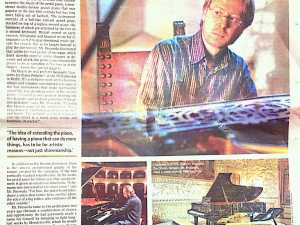20 April 2012 Wall Street Journal
Article about Roberto Prosseda and the Pedalpiano
Roberto Prosseda is a concert pianist of the old school who typically performs in white tie and tails. But for his most recent spate of concerts, he pairs them with slippers—five-fingered rubber-coated slippers that look vaguely amphibian. That's because Mr. Prosseda plays with his feet as well as his hands.The Italian pianist is on a one-man mission to revive the music of the pedal piano, a monstrous double-decker grand piano that was popular in the late-19th century but has long since fallen out of fashion.
The instrument consists of a full-size concert grand piano stacked on top of a legless second piano, the hammers of which are activated by the feet on a second keyboard. Mozart owned an early version, Schumann and Gounod wrote for it; organists used it to play devotional music outside the church. But as he taught himself to play the instrument, Mr. Prosseda discovered that unlike the foot pedals of an organ, which don't directly control subtle changes in dynamic and attack, the pedal piano requires the player to be as sensitive in the toes as in the fingers—hence the special slippers.
On May 6, he will perform Gounod's "Concerto for Piano-Pédalier" at the Philharmonie in Berlin. It's a virtuosic work with a luscious adagio and complex contrapuntal passages in the fast movements that make spectacular use of the low, growling notes of the second piano. "Gounod is very good at drawing out the dramatic and gestural potential of the piano-pédalier," says Mr. Prosseda, 37, using the French name of the instrument. "It's a very dialectic relationship between the feet and hands. The pédalier is a dark character, and the other is a much more tender and feminine character."
In addition to the theatrical element, there is the almost architectural quality of the sound, created by the interplay of the two vertically stacked soundboards. In the works for pedal piano by Schumann, that spatial element is given an emotional dimension. "Schumann was interested in the inner voice," says Mr. Prosseda. "For him, the pedal board introduces a voice that comes from another place, the voice of a big father, who embraces all the other sounds."
At that point, Mr. Prosseda had only rudimentary command of organ technique. "But I was very much aware that you cannot play a pedal piano as if it was an organ," he says. "It doesn't work because you need a special way to project the sound in the hall, and to have different kinds of touch, attacking the key with different part of the foot at different angles. The principles of modern piano technique have to be transferred to the feet."For some pianissimo notes, that means using a single toe. To gain the necessary sensitivity, he says, he experimented with socks ("too slippery"), jazz dance shoes ("almost elegant") and bare feet ("too painful"). In the end, he turned to Vibram, the Italian company behind the Five Finger barefoot running shoe, and settled on a model designed for yoga and Pilates.
Mr. Prosseda's enthusiasm for the pedal piano is beginning to infect others. Over the past year, he has commissioned 10 composers, among them Michael Nyman and Ennio Morricone, to write new works for the instrument. The organ builder Pinchi has built a kind of trundle pédalier for Mr. Prosseda that can be attached to the underside of any regular grand piano, making travel less cumbersome.
Mr. Prosseda is also working on developing a virtual pedal board that could be attached to a regular piano, a sort of trolley equipped with infrared and optical sensors that could capture the motion of the performer's feet and translate them into sounds, acoustical effects and even lights and colors. "What I hope is to give a new creative tool to composers and artists," says Mr. Prosseda. "Because the idea of extending the piano, of having a piano that can do more things, has to be for artistic reasons—not just showmanship."



